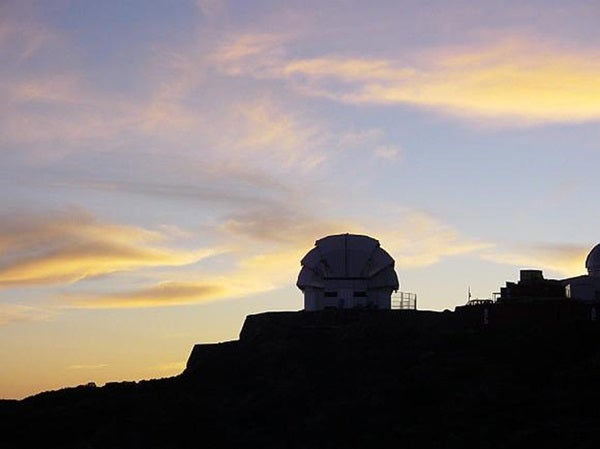The Liverpool Telescope has used a unique scientific camera (named RINGO) to measure the polarization of the light from a gamma-ray burst (GRB) and show that strong magnetic fields are responsible for beaming the light toward Earth.
GRBs form when the core of a massive star collapses or two neutron stars merge together. The resulting explosions are the brightest events in the universe, vastly outshining entire galaxies containing hundreds of billions of stars. Satellites orbiting Earth can detect this energy.
GRB 090102 occurred January 2, 2009, and it was detected by NASA’s Swift satellite, which sent an immediate notification over the Internet to telescopes all over the world. The robotic Liverpool Telescope on the island of La Palma reacted automatically and swung around to observe the burst with a special camera that uses a spinning disk of Polaroid (as used in a pair of sunglasses).
“By observing how the brightness of the GRB varied as we span the Polaroid, we could measure the magnetic field in the burst,” said Iain Steele, irector of the Liverpool Telescope.
This is the first time such a measurement has been made within a few minutes of the explosion and the Liverpool John Moores University (LJMU) team discovered that a well-ordered magnetic field was present. “Theoreticians predicted that such a magnetic field is generated in the central fireball and accelerates GRB jets to almost the speed of light,” said Shiho Kobayashi of the LJMU GRB research team. “Now the existence of strong magnetic fields has been shown to be correct.”
“This breakthrough observation gives us the first measurement of magnetic fields in the afterglow of a GRB,” said Swift lead scientist Neil Gehrels at NASA’s Goddard Space Flight Center in Greenbelt, Maryland.
“These very interesting observations raise the possibility that gamma-ray bursts are not fireballs as usually presumed, but they are powered and collimated by organized electromagnetic field,” said Roger Blandford, director of the Kavli Institute of Particle Astrophysics and Cosmology at Stanford University. “It will be very interesting to see if there are similarities in observations of other kinds of cosmic jets.”
“This important result gives us new insight into the physics of these remarkable objects and is a testament to the close collaboration between observers, theoreticians, and technologists in the Liverpool and NASA Swift teams,” said Carole Mundell, leader of the LJMU GRB team. “It’s incredible to think that the GRB discovery and our measurement process — from first detection and notification by NASA’s Swift satellite to the polarization measurement using RINGO on the Liverpool Telescope — took place completely automatically within less than 3 minutes and with no human intervention!”










